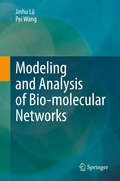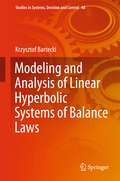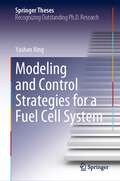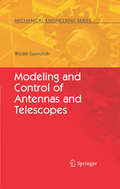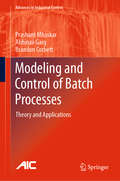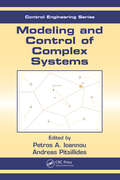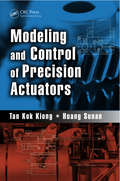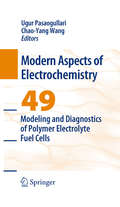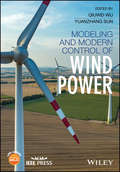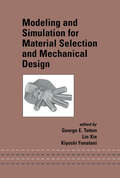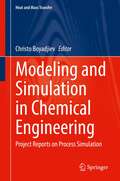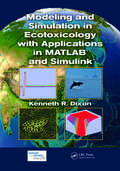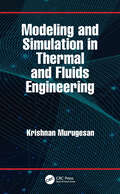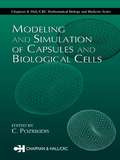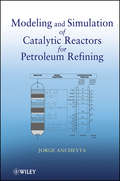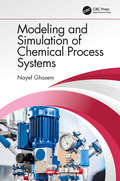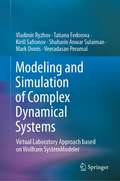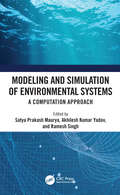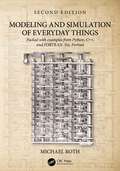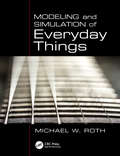- Table View
- List View
Modeling and Analysis of Bio-molecular Networks
by Pei Wang Jinhu LüThis book addresses a number of questions from the perspective of complex systems: How can we quantitatively understand the life phenomena? How can we model life systems as complex bio-molecular networks? Are there any methods to clarify the relationships among the structures, dynamics and functions of bio-molecular networks? How can we statistically analyse large-scale bio-molecular networks? Focusing on the modeling and analysis of bio-molecular networks, the book presents various sophisticated mathematical and statistical approaches. The life system can be described using various levels of bio-molecular networks, including gene regulatory networks, and protein-protein interaction networks. It first provides an overview of approaches to reconstruct various bio-molecular networks, and then discusses the modeling and dynamical analysis of simple genetic circuits, coupled genetic circuits, middle-sized and large-scale biological networks, clarifying the relationships between the structures, dynamics and functions of the networks covered. In the context of large-scale bio-molecular networks, it introduces a number of statistical methods for exploring important bioinformatics applications, including the identification of significant bio-molecules for network medicine and genetic engineering. Lastly, the book describes various state-of-art statistical methods for analysing omics data generated by high-throughput sequencing. This book is a valuable resource for readers interested in applying systems biology, dynamical systems or complex networks to explore the truth of nature.
Modeling and Analysis of Linear Hyperbolic Systems of Balance Laws
by Krzysztof BarteckiThismonograph focuses on the mathematical modeling of distributed parameter systemsin which mass/energy transport or wave propagation phenomena occur and whichare described by partial differential equations of hyperbolic type. The case oflinear (or linearized) 2 x 2 hyperbolic systems of balance laws isconsidered, i. e. , systems described by two coupled linear partial differentialequations with two variables representing physical quantities, depending onboth time and one-dimensional spatial variable. Basedon practical examples of a double-pipe heat exchanger and a transportationpipeline, two typical configurations of boundary input signals are analyzed: collocated, wherein both signals affect the system at the samespatial point, and anti-collocated, inwhich the input signals are applied to the two different end points of thesystem. Theresults of this book emerge from the practical experience of the author gainedduring his studies conducted in the experimental installation of a heatexchange center as well as from his research experience in the field of mathematicaland computer modeling of dynamic systems. The book presents valuable resultsconcerning their state-space, transfer function and time-domain representations,which can be useful both for the open-loop analysis as well as for theclosed-loop design. Thebook is primarily intended to help professionals as well as undergraduate andpostgraduate students involved in modeling and automatic control of dynamicsystems.
Modeling and Approximation in Heat Transfer
by Leon R. Glicksman John H. Lienhard VEngineers face many challenges in systems design and research. Modeling and Approximation in Heat Transfer describes the approach to engineering solutions through simplified modeling of the most important physical features and approximating their behavior. Systematic discussion of how modeling and associated synthesis can be carried out is included - in engineering practice, these steps very often precede mathematical analysis or the need for precise results.
Modeling and Control Strategies for a Fuel Cell System (Springer Theses)
by Yashan XingThis book reports on a comprehensive study on the modeling, online and offline parameter estimation and control strategies for fuel cell systems. Upon reviewing the control-oriented modeling of proton-exchange membrane fuel cell systems (PEMFC) and solid oxide fuel cell systems (SOFC), it describes a new a set of methodologies to estimate the parameters of these models, both online and offline. In turn, it reports on the design of different control systems for PEMFC and SOFC. Experimental findings are shown to demonstrate the efficiency of the newly developed methods in practical applications, and their improved performance over classical methods.
Modeling and Control of Antennas and Telescopes
by Wodek GawronskiThe book shows, step by step, the design, implementation, and testing of the antenna/telescope control system, from the design stage (analytical model) to fine tuning of the RF beam pointing (monopulse and conscan). The purpose of this book is to present the implementation of the new theoretical developments in structural dynamics and control theory in the antenna and telescope industry. Also to present the significant improvement in pointing accuracy of the antenna and telescope when the presented techniques are implemented. This book fills the need in the antenna/telescope control techniques. For long time, since 1990 when the last book was published, there was no publication on the antenna/telescope/radar modeling and control.
Modeling and Control of Batch Processes: Theory and Applications (Advances in Industrial Control)
by Prashant Mhaskar Abhinav Garg Brandon CorbettModeling and Control of Batch Processes presents state-of-the-art techniques ranging from mechanistic to data-driven models. These methods are specifically tailored to handle issues pertinent to batch processes, such as nonlinear dynamics and lack of online quality measurements. In particular, the book proposes:a novel batch control design with well characterized feasibility properties;a modeling approach that unites multi-model and partial least squares techniques;a generalization of the subspace identification approach for batch processes; and applications to several detailed case studies, ranging from a complex simulation test bed to industrial data. The book’s proposed methodology employs statistical tools, such as partial least squares and subspace identification, and couples them with notions from state-space-based models to provide solutions to the quality control problem for batch processes. Practical implementation issues are discussed to help readers understand the application of the methods in greater depth. The book includes numerous comments and remarks providing insight and fundamental understanding into the modeling and control of batch processes. Modeling and Control of Batch Processes includes many detailed examples of industrial relevance that can be tailored by process control engineers or researchers to a specific application. The book is also of interest to graduate students studying control systems, as it contains new research topics and references to significant recent work. Advances in Industrial Control reports and encourages the transfer of technology in control engineering. The rapid development of control technology has an impact on all areas of the control discipline. The series offers an opportunity for researchers to present an extended exposition of new work in all aspects of industrial control.
Modeling and Control of Complex Systems (ISSN #26)
by Andreas Pitsillides Petros A. IoannouThere is an emerging interest in the area of modeling and control of complex systems for applications in many engineering and non-engineering fields such as biology, transportation, robotics, information technology, and communications. This text provides a pioneering, single-source compilation of material from internationally renowned experts with different approaches to the applications of modeling and control of complex systems. Sections cover complex systems, biological systems, communication networks, sensor networks and automation, autonomous vehicles and robotics, transportation systems and structures, and others. The authors highlight the most important areas of research, the latest advances, and possible future directions.
Modeling and Control of Precision Actuators
by Tan Kok Kiong Huang SunanModeling and Control of Precision Actuators explores new technologies that can ultimately be applied in a myriad of industries. It covers dynamical analysis of precise actuators and strategies of design for various control applications. The book addresses four main schemes: modeling and control of precise actuators; nonlinear control of precise actuators, including sliding mode control and neural network feedback control; fault detection and fault-tolerant control; and advanced air bearing control. It covers application issues in the modeling and control of precise actuators, providing several interesting case studies for more application-oriented readers. Introduces the driving forces behind precise actuators Describes nonlinear dynamics of precise actuators and their mathematical forms, including hysteresis, creep, friction, and force ripples Presents the control strategies for precise actuators based on Preisach model as well as creep dynamics Develops relay feedback techniques for identifying nonlinearities such as friction and force ripples Discusses a MPC approach based on piecewise affine models which emulate the frictional effects in the precise actuator Covers the concepts of air bearing stages with the corresponding control method Provides a set of schemes suitable for fault detection and accommodation control of mechanical systems Emphasizing design theory and control strategies, the book includes simulation and practical examples for each chapter; covers precise actuators such as piezo motors, coil motors, air bearing motors, and linear motors; discusses integration among different technologies; and includes three case studies in real projects. The book concludes by linking design methods and their applications, emphasizing the key issues involved and how to implement the precision motion control tasks in a practical system. It provides a concise and comprehensive source of the state-of-the-art developments and results for modeling and control of precise actuators.
Modeling and Diagnostics of Polymer Electrolyte Fuel Cells
by Ugur Pasaogullari Chao-Yang WangThis volume of Modern Aspects in Electrochemistry covers the latest advances in diagnostics and modeling of polymer electrolyte fuel cells, presented by leading experts in the field. The volume is divided into two parts: part I reviews the state of the art in diagnostics of low temperature fuel cells, while part II covers the relevant modeling efforts.
Modeling and Modern Control of Wind Power
by Qiuwei Wu Yuanzhang SunAn essential reference to the modeling techniques of wind turbine systems for the application of advanced control methods This book covers the modeling of wind power and application of modern control methods to the wind power control—specifically the models of type 3 and type 4 wind turbines. The modeling aspects will help readers to streamline the wind turbine and wind power plant modeling, and reduce the burden of power system simulations to investigate the impact of wind power on power systems. The use of modern control methods will help technology development, especially from the perspective of manufactures. Chapter coverage includes: status of wind power development, grid code requirements for wind power integration; modeling and control of doubly fed induction generator (DFIG) wind turbine generator (WTG); optimal control strategy for load reduction of full scale converter (FSC) WTG; clustering based WTG model linearization; adaptive control of wind turbines for maximum power point tracking (MPPT); distributed model predictive active power control of wind power plants and energy storage systems; model predictive voltage control of wind power plants; control of wind power plant clusters; and fault ride-through capability enhancement of VSC HVDC connected offshore wind power plants. Modeling and Modern Control of Wind Power also features tables, illustrations, case studies, and an appendix showing a selection of typical test systems and the code of adaptive and distributed model predictive control. Analyzes the developments in control methods for wind turbines (focusing on type 3 and type 4 wind turbines) Provides an overview of the latest changes in grid code requirements for wind power integration Reviews the operation characteristics of the FSC and DFIG WTG Presents production efficiency improvement of WTG under uncertainties and disturbances with adaptive control Deals with model predictive active and reactive power control of wind power plants Describes enhanced control of VSC HVDC connected offshore wind power plants Modeling and Modern Control of Wind Power is ideal for PhD students and researchers studying the field, but is also highly beneficial to engineers and transmission system operators (TSOs), wind turbine manufacturers, and consulting companies.
Modeling and Simulation for Material Selection and Mechanical Design (Mechanical Engineering)
by George E. Totten Lin Xie Kiyoshi FunataniThis reference describes advanced computer modeling and simulation procedures to predict material properties and component design including mechanical properties, microstructural evolution, and materials behavior and performance. The book illustrates the most effective modeling and simulation technologies relating to surface-engineered compounds, fastener design, quenching and tempering during heat treatment, and residual stresses and distortion during forging, casting, and heat treatment. With contributions from internationally recognized experts in the field, it enables researchers to enhance engineering processes and reduce production costs in materials and component development.
Modeling and Simulation in Chemical Engineering: Project Reports on Process Simulation (Heat and Mass Transfer)
by Christo BoyadjievThis book presents a theoretical analysis of the modern methods used for modeling various chemical engineering processes. Currently, the two primary problems in the chemical industry are the optimal design of new devices and the optimal control of active processes. Both of these problems are often solved by developing new methods of modeling. These methods for modeling specific processes may be different, but in all cases, they bring the mathematical description closer to the real processes by using appropriate experimental data. In this book, the authors detail a new approach for the modeling of chemical processes in column apparatuses. Further, they describe the types of neural networks that have been shown to be effective in solving important chemical engineering problems. Readers are also presented with mathematical models of integrated bioethanol supply chains (IBSC) that achieve improved economic and environmental sustainability. The integration of energy and mass processes is one of the most powerful tools for creating sustainable and energy efficient production systems. This book defines the main approaches for the thermal integration of periodic processes, direct and indirect, and the recent integration of small-scale solar thermal dryers with phase change materials as energy accumulators. An exciting overview of new approaches for the modeling of chemical engineering processes, this book serves as a guide for the important innovations being made in theoretical chemical engineering.
Modeling and Simulation in Ecotoxicology with Applications in MATLAB and Simulink
by Kenneth R. DixonExploring roles critical to environmental toxicology, Modeling and Simulation in Ecotoxicology with Applications in MATLAB and Simulink covers the steps in modeling and simulation from problem conception to validation and simulation analysis. Using the MATLAB and Simulink programming languages, the book presents examples of mathematical functions a
Modeling and Simulation in Thermal and Fluids Engineering
by Krishnan MurugesanThis textbook comprehensively covers the fundamentals behind mathematical modeling of engineering problems to obtain the required solution. It comprehensively discusses modeling concepts through conservation principles with a proper blending of mathematical expressions. The text discusses the basics of governing equations in algebraic and differential forms and examines the importance of mathematics as a tool in modeling. It covers important topics including modeling of heat transfer problems, modeling of flow problems, modeling advection-diffusion problems and Navier-Stokes equations in depth. Pedagogical features including solved problems and unsolved exercises are interspersed throughout the text for better understanding. The textbook is primarily written for senior undergraduate and graduate students in the field of mechanical engineering for courses on modeling and simulation. The textbook will be accompanied by teaching resource including a solution manual for the instructors.
Modeling and Simulation of Capsules and Biological Cells (Chapman And Hall/crc Mathematical Biology Ser.)
by C. PozrikidisIn the past three decades, considerable progress has been made in the mathematical analysis, modelling, and simulation of the fluid dynamics of liquid capsules and biological cells, and interest in this area is now at an all-time high. This book features a collection of chapters contributed by acknowledged leaders in the field who explore topics re
Modeling and Simulation of Catalytic Reactors for Petroleum Refining
by Jorge AncheytaModeling and Simulation of Catalytic Reactors for Petroleum Refining deals with fundamental descriptions of the main conversion processes employed in the petroleum refining industry: catalytic hydrotreating, catalytic reforming, and fluid catalytic cracking. Common approaches for modeling of catalytic reactors for steady-state and dynamic simulations are also described and analyzed. Aspects such as thermodynamics, reaction kinetics, process variables, process scheme, and reactor design are discussed in detail from both research and commercial points of view. Results of simulation with the developed models are compared with those determined at pilot plant scale as well as commercial practice. Kinetics data used in the reactor model are either taken from the literature or obtained under controlled experiments at the laboratory.
Modeling and Simulation of Chemical Process Systems
by Nayef GhasemIn this textbook, the author teaches readers how to model and simulate a unit process operation through developing mathematical model equations, solving model equations manually, and comparing results with those simulated through software. It covers both lumped parameter systems and distributed parameter systems, as well as using MATLAB and Simulink to solve the system model equations for both. Simplified partial differential equations are solved using COMSOL, an effective tool to solve PDE, using the fine element method. This book includes end of chapter problems and worked examples, and summarizes reader goals at the beginning of each chapter.
Modeling and Simulation of Complex Dynamical Systems: Virtual Laboratory Approach based on Wolfram SystemModeler
by Shaharin Anwar Sulaiman Vladimir Ryzhov Tatiana Fedorova Kirill Safronov Mark Ovinis Veeradasan PerumalThis book highlights the practical aspects of computer modelling and simulation of complex dynamical systems for students. Mechanical systems are considered in the book as representative examples of dynamical systems. Wolfram SystemModeler, in combination with Learning Management System Sakai, is used as an instrument for studying features of various physical and technical phenomena and processes. Each of the presented virtual labs may be considered a stand-alone mini project to enable students to go through all the steps of mathematical modelling and computer simulation—from the problem statement to mathematical and physical analysis of the obtained result. The book is useful for teachers to organize the educational process, allowing gradual monitoring of the learning process and assessment of students’ competencies. It also allows tutors to design individual educational trajectories for students to achieve educational properties. The subject of the book is an extension of activity started by the international team of authors within the InMotion project of the European programme ERASMUS+.
Modeling and Simulation of Environmental Systems: A Computation Approach
by Ramesh Singh Satya Prakash Maurya Akhilesh Kumar YadavThis book presents an overview of modeling and simulation of environmental systems via diverse research problems and pertinent case studies. It is divided into four parts covering sustainable water resources modeling, air pollution modeling, Internet of Things (IoT) based applications in environmental systems, and future algorithms and conceptual frameworks in environmental systems. Each of the chapters demonstrate how the models, indicators, and ecological processes could be applied directly in the environmental sub-disciplines. It includes range of concepts and case studies focusing on a holistic management approach at the global level for environmental practitioners. Features: Covers computational approaches as applied to problems of air and water pollution domain. Delivers generic methods of modeling with spatio-temporal analyses using soft computation and programming paradigms. Includes theoretical aspects of environmental processes with their complexity and programmable mathematical approaches. Adopts a realistic approach involving formulas, algorithms, and techniques to establish mathematical models/computations. Provides a pathway for real-time implementation of complex modeling problem formulations including case studies. This book is aimed at researchers, professionals and graduate students in Environmental Engineering, Computational Engineering/Computer Science, Modeling/Simulation, Environmental Management, Environmental Modeling and Operations Research.
Modeling and Simulation of Everyday Things
by Michael RothWith Python, C++, FORTRAN, and a friendly conversational tone peppered with attempted humor, Modeling and Simulation of Everyday Things takes us on a journey through constructing models and simulations of systems and processes in everyday life and beyond. Readers can access an example‑packed online repository of programs in each of the three languages, including seldom covered work in generalized geometries and 3D.This second edition is a wonderful confluence of development of Python and C++ applications and will cultivate a broad perspective in the readership through having translations of major programs available in Python, C++, and FORTRAN (as we move forward, software engineers and researchers are recognizing the value of legacy programming). In addition to leveraging the best of the three languages, the readership can explore versatility in visualization by using native Python graphics as well as POV Raytracer and third‑party animation tools. We approach modeling of a system by introducing the theoretical framework of the system, followed by its discretized form, and then with narrated programs and sample results that also appear in the online repository.Readers will be able to critically think through constructing models and simulations of a vast array of systems, interpreting results, and visualizing them (which includes examples for visually and auditorily impaired individuals). Most importantly, their confidence will propel them forward to meet the challenges of the field and to think "outside the book". Leveraging the best of three coding languages, two tracks for visualization, a conversational tone, and numerous examples, this book is extremely versatile and can be used by students from high school through science undergraduates in 2‑year and 4‑year institutions. The text is also ideal for use in Data Science as well as Professional Science Master’s programs.
Modeling and Simulation of Everyday Things
by Michael W. RothHow can computer modeling and simulation tools be used to understand and analyze common situations and everyday problems? Readers will find here an easy-to-follow, enjoyable introduction for anyone even with little background training. Examples are incorporated throughout to stimulate interest and engage the reader. Build the necessary skillsets with operating systems, editing, languages, commands, and visualization. Obtain hands-on examples from sports, accidents, and disease to problems of heat transfer, fluid flow, waves, and groundwater flow. Includes discussion of parallel computing and graphics processing units. This introductory, practical guide is suitable for students at any level up to professionals looking to use modeling and simulation to help solve basic to more advanced problems. Michael W. Roth, PhD, serves as Dean of the School of STEM and Business at Hawkeye Community College in Waterloo, Iowa. He was most recently Chair for three years at Northern Kentucky University's Department of Physics, Geology and Engineering Technology, and holds several awards for teaching excellence.
Modeling and Simulation of Fluidized Bed Reactors for Chemical Looping Combustion
by Ramesh K. Agarwal Yali ShaoThe book describes the clean coal technology of chemical looping combustion (CLC) for power generation with pure CO2 capture. The focus of the book is on the modeling and simulation of CLC. It includes fundamental concepts behind CLC and considers all categories of fluidized beds and reactors, including a variety of oxygen carriers. The book includes process simulations with Aspen Plus® software using coal, natural gas, and biomass and computational fluid dynamics (CFD) simulations using both the Eulerian and Lagrangian methods. It describes various drag models, turbulence models, and kinetics models required for CFD simulations of CLC and covers single reactor, partial, and full-simulations, single/multi-stage as well as single-particle simulations, and CLC with reverse flow. A large number of examples for both process simulations using Aspen Plus and CFD simulations using a variety of fluidized beds/reactors employing both the two-fluid and Computational Fluid Dynamics / Discrete Element Method (CFD-DEM) model are provided. Modeling and Simulation of Fluidized Bed Reactors for Chemical Looping Combustion will be an invaluable reference for industry practitioners and researchers in academic and industrial R&D currently working on clean energy technologies and power generation with carbon capture.
Modeling and Simulation of Heterogeneous Catalytic Reactions: From the Molecular Process to the Technical System
by Olaf DeutschmannThe Nobel Prize in Chemistry 2007 awarded to Gerhard Ertl for his groundbreaking studies in surface chemistry highlighted the importance of heterogeneous catalysis not only for modern chemical industry but also for environmental protection. Heterogeneous catalysis is seen as one of the key technologies which could solve the challenges associated with the increasing diversification of raw materials and energy sources. It is the decisive step in most chemical industry processes, a major method of reducing pollutant emissions from mobile sources and is present in fuel cells to produce electricity. The increasing power of computers over the last decades has led to modeling and numerical simulation becoming valuable tools in heterogeneous catalysis. This book covers many aspects, from the state-of-the-art in modeling and simulations of heterogeneous catalytic reactions on a molecular level to heterogeneous catalytic reactions from an engineering perspective. This first book on the topic conveys expert knowledge from surface science to both chemists and engineers interested in heterogeneous catalysis. The well-known and international authors comprehensively present many aspects of the wide bridge between surface science and catalytic technologies, including DFT calculations, reaction dynamics on surfaces, Monte Carlo simulations, heterogeneous reaction rates, reactions in porous media, electro-catalytic reactions, technical reactors, and perspectives of chemical and automobile industry on modeling heterogeneous catalysis. The result is a one-stop reference for theoretical and physical chemists, catalysis researchers, materials scientists, chemical engineers, and chemists in industry who would like to broaden their horizon and get a substantial overview on the different aspects of modeling and simulation of heterogeneous catalytic reactions.
Modeling and Simulation of Infectious Diseases: Microscale Transmission, Decontamination and Macroscale Propagation
by Tarek I. ZohdiThe COVID-19 pandemic that started in 2019-2020 has led to a gigantic increase in modeling and simulation of infectious diseases. There are numerous topics associated with this epoch-changing event, such as (a) disease propagation, (b) transmission, (c) decontamination, and (d) vaccines. This is an evolving field. The targeted objective of this book is to expose researchers to key topics in this area, in a very concise manner. The topics selected for discussion have evolved with the progression of the pandemic. Beyond the introductory chapter on basic mathematics, optimization, and machine learning, the book covers four themes in modeling and simulation infectious diseases, specifically: Part 1: Macroscale disease propagation, Part 2: Microscale disease transmission and ventilation system design, Part 3: Ultraviolet viral decontamination, and Part 4: Vaccine design and immune response. It is important to emphasize that the rapid speed at which the simulations operate makes the presented computational tools easily deployable as digital twins, i.e., digital replicas of complex systems that can be inexpensively and safely optimized in a virtual setting and then used in the physical world afterward, thus reducing the costs of experiments and also accelerating development of new technologies.
Modeling and Simulation of Lithium-ion Power Battery Thermal Management (Key Technologies on New Energy Vehicles)
by Junqiu LiThis book focuses on the thermal management technology of lithium-ion batteries for vehicles. It introduces the charging and discharging temperature characteristics of lithium-ion batteries for vehicles, the method for modeling heat generation of lithium-ion batteries, experimental research and simulation on air-cooled and liquid-cooled heat dissipation of lithium-ion batteries, lithium-ion battery heating method based on PTC and wide-line metal film, self-heating using sinusoidal alternating current. This book is mainly for practitioners in the new energy vehicle industry, and it is suitable for reading and reference by researchers and engineering technicians in related fields such as new energy vehicles, thermal management and batteries. It can also be used as a reference book for undergraduates and graduate students in energy and power, electric vehicles, batteries and other related majors.
